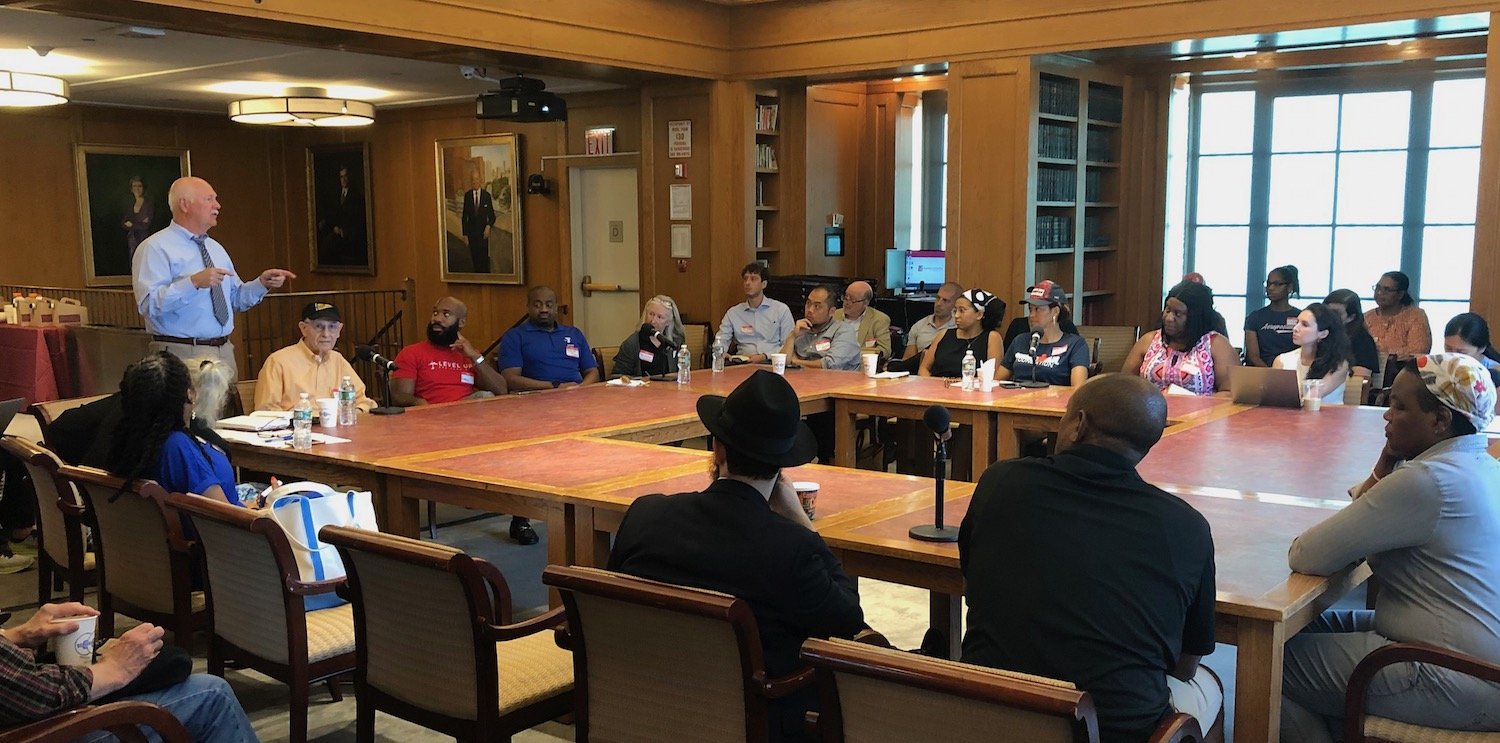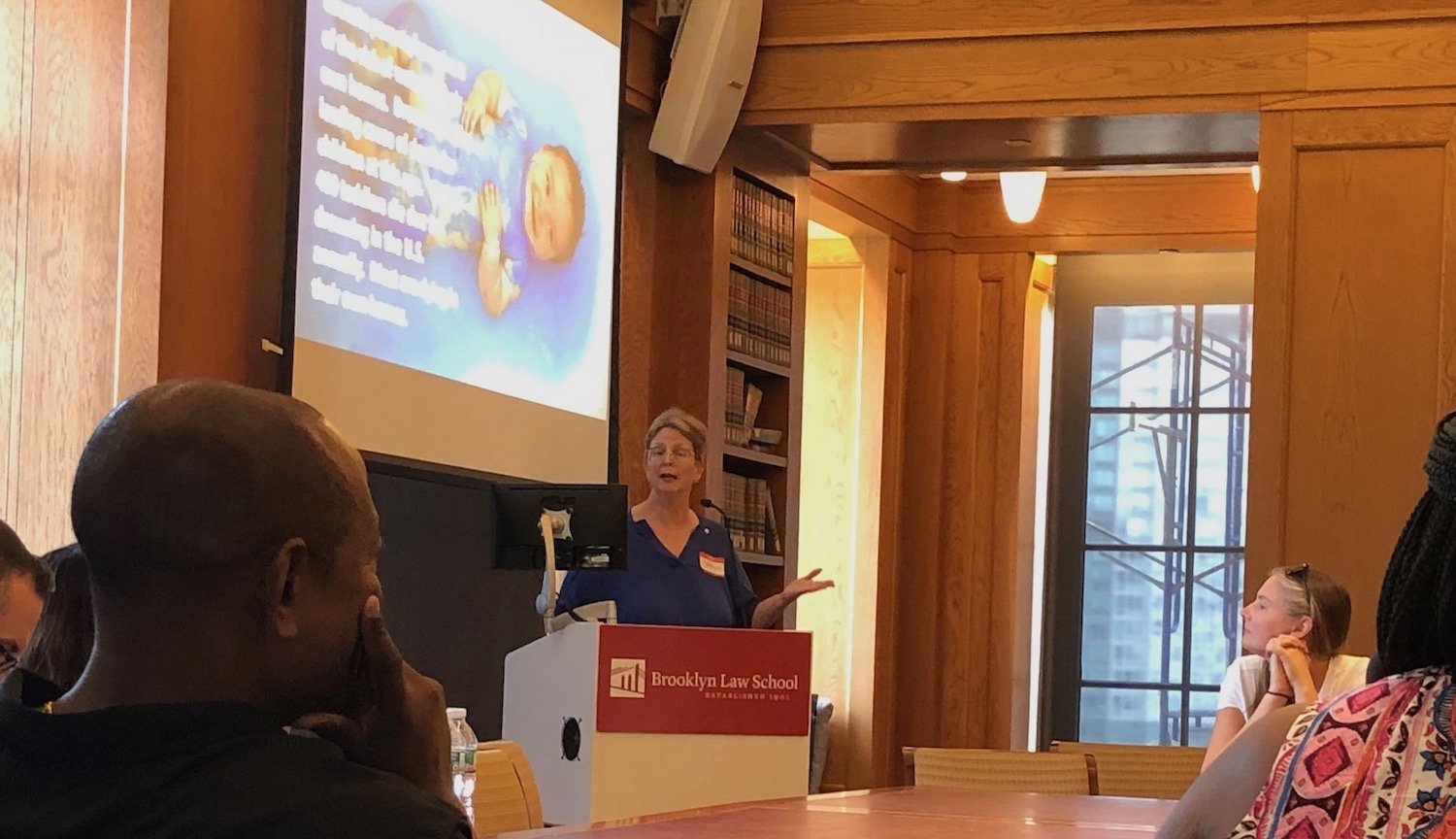Brooklyn Symposium offers Critical Insights on NYC Aquatics
BROOKLYN HEIGHTS. Last Friday at Brooklyn Law School—far from robust swim activity at Coney Island or Rockaway Beach—noted aquatics advocates and concerned New Yorkers gathered to confront the many issues that plague the city this summer and make for dangerous inequity on the New York City swim scene: among them a lack of lifeguards, a lack of access to pools, and a scarcity of people familiar with water safety basics. Representatives from NYC Parks, the YMCA, the Red Cross, NYC DOE, the NYC City Council as well as non-profits including Inclusive Community Wellness (ICW), the Magnus Mukoro Foundation, Musa Swims, + Pool, Rising Tide Effect, Swim Strong Foundation and Tankproof discussed and debated solutions to these and other concerns such as drowning, a dearth of learn-to-swim instruction and difficult access to water.
The diverse participants of the symposium “Water, Water Everywhere, but for Many New Yorkers No Swimming or Safety” recognized the magnitude of problems affecting New Yorkers of every age, race and economic status. After a morning of presentations and roundtable discussion, it became clear that all present must become active advocates for change, continue to share experience and expertise, and collectively craft solutions.
A life saved from drowning
Sheridan Jack-Browne Mukoro, director of the Magnus Mukoro Foundation, opened the proceedings, describing her grief at the accidental drowning of her husband, Magnus, on a family vacation eight years ago. Mukoro’s tragic death caused Jack-Brown to rethink her understanding of racial barriers to swimming proficiency. The organization she founded in her husband’s name is committed to preventing drowning for all ages.
[Sheridan Jack-Browne Mukoro: Why My Husband’s Death Matters]
Jack-Browne’s message was amplified by the symposium’s closing presentation. Shawn Slevin of Swim Strong Foundation presented a cradle to grave assessment of aquatics, emphasizing how education—in the form of land- and water-based instruction—dramatically reduces the number of drowning incidents in New York City. Kaitlin Krause of Rising Tide Effect paralleled Slevin’s education focus, describing her organization’s efforts to instruct boys and girls in the Rockaways about water safety, drown-proofing and learn-to-swim skills.
Shawn Slevin of Swim Strong Foundation. Photo: M. Randazzo
Responding to a lifeguard shortage that has caused NYC Parks to cut services and close beaches—and put a spotlight on the practices of the city’s lifeguard union—Chief Lifeguard Janet Fash posted on a symposium chat that training for new lifeguards has to take place in more than a single Manhattan location, as is the current situation. Her position was underscored by former St. Francis College Aquatics Director Carl Quigley, who stressed that bringing in more prospects is a critical issue. This summer 500 of the approximately 1,400 spots for city lifeguards went unfilled.
[Rockaways Roundtable: New York City Aquatic Culture?]
Where are the lifeguards???
Representatives from the YMCA and the Red Cross spoke about their efforts to fill the guard gap for NYC private pools. Mary O’Donohue explained how the YMCA of New York City responded to the pressing need for lifeguards by offering free Red Cross Certification to those 16 years old and up. Vlad Frenkel, a Red Cross lifeguard trainer, detailed how he certified 14 high school and college students as lifeguards in Brooklyn after splitting pool time between Brooklyn and Manhattan. Emilianna and James Gonzalez, two of the newly minted guards, were in attendance and spoke about the benefits of lifeguarding after a lifetime connection with swimming.
James Gonzalez, lifeguard
Moving to the issue of learn-to-swim programs, Paul Fontana of NYC Parks detailed the steps his department is taking to double the size of the Swim for Life program, slated to work with as many as 12.000 public school second graders this year. Ben Greene, a parent who is on the board of District 13’s Community Education Council (D13 CEC), pushed back, asking how, given space limitations, parents and schools can get their children into this program. Scalability comes down to access to pools and availability of instructors. Thanks to $5.3 million added in the 2023-24 NYC budget, Parks will double its swim instruction staff, and parents like Greene are desperate to know how their children can be included.
[Bigger Pool of Funds Will Teach 6,000 City Kids to Swim]
Rabbi Yaakov Raskin of Chabad of Brooklyn Heights pointed out that the city’s lifeguard shortage has directly impacted NYC summer camps. Where both subsidized and exclusive camps used public outdoor pools to provide swim instruction to their campers, the lack of lifeguards has caused Parks to stop issuing permits for camp swim instruction at outdoor pools. This loss potentially has a generational effect; Raskin pointed out a nephew reluctant to swim that his grandfather and father had all been lifeguards, making swimming a rite of passage in the Raskin family.
Not enough swim lessons or pools
Councilmember Shekar Krishnan of Queens was quite critical about how the city provides for its citizens’ aquatic needs. He passionately described the city’s annual swimming crisis, then took feedback from participants about how more swim lessons and lifeguards can become available. Krishnan’s comments were echoed by Jack Seigenthaler, representing Councilmember Selvena Brooks-Powers, also of Queens. Like Krishnan, Brooks-Powers has sponsored aquatics bills in the city council to address the problems with lifeguards and swimming.
[NYC Council takes up bills to expand pool access citywide]
Tracy Caldron made one of the more powerful appeals for change. Executive director of Musa Swim, Caldron detailed how her organization provides learn-to-swim instruction to high school boys in Brownsville and New Lots, with the goal of getting them Red Cross lifeguard certification and jobs. Caldron’s struggle to secure pool time and financial support underscored the barriers facing everyday New Yorkers who want to enjoy the water and find employment through aquatics.
Musa Swim lifeguard program at Thomas Jefferson High School
Krystal Freed of Tankproof, a Texas-based community services program, presented her organization’s model for offering swim lessons to children in cities across the country, including New York. Their biggest obstacle in the City is one that plagues most of the symposium participants: access to pool time.
In one of the day’s most imaginative presentations, Kara Meyer of + Pool displayed her organization’s innovative and architecturally striking solution to the city’s lack of swim space. + Pool will float in the Hudson River, a clever response to the massively high real estate valuations in New York. Yet be built, + Pool will have to overcome significant city and state hurdles. But a floating pool is not the organization’s only aquatics effort. They also provide free learn-to-swim instruction and water safety lessons and are working to open up New York City’s many miles of coast to recreational swimming.
+ Pool rendering in Brooklyn Bridge Park. Photo: + Pool
Perhaps the most immediate solution to the lack of pool space came from Quigley, who has been a collegiate swimmer, a lifeguard, a coach and an aquatics director. He proposed installing a temporary pool under a bubble at the Red Hook Recreation Center. Taking advantage of the facility’s infrastructure—bathrooms, locker rooms and a broad footprint provided by an existing Robert Moses era swimming pool—Quigley’s proposal offers a relatively cost-effective facility that could serve everyone from young children to adults, from high school to collegiate athletic teams and from scuba training to individuals with disabilities. In short, a complete spectrum of New Yorkers, all of whom need, and deserve, access to adequate swim facilities. According to Quigley, much of the capital cost of this solution may be recovered by resale of the portable pool’s pieces.
Red Hook Pool, built in 1936, a summer staple in NYC. Photo: NYC Parks
What ensues on the New York swim scene may be influenced by the symposium’s participants. But the vicissitudes of City finances and political realities remain and may militate against change. One thing was clear, though, and was underscored by the overlap between many of the presenters’ programs: only through collaboration among the various stakeholders will NYC’s swimming and lifeguard crisis be tackled and eradicated.






